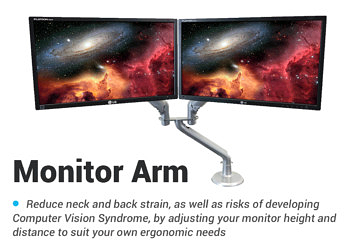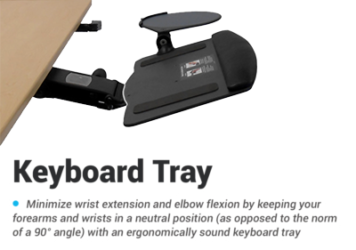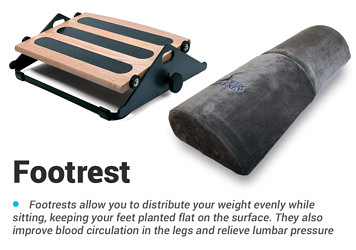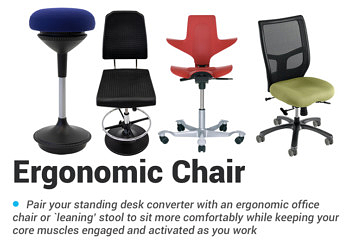Autonomous SmartDesk 2 Standing Desk Review
Like most reviews sites, our editorial staff and laboratory testing expenses are partially offset by earning small commissions (at no cost to you) when you purchase something through those links. Learn More

Overview
| Review Summary |
The company makes over-the-top marketing claims like “the highest-rated desk in the world” and maintains its bases are of “unparalleled technology.” As far as we can tell, the only things this company is “best in the world” at is their gift for marketing hyperbole, and finding the cheapest possible components to make a standing desk. Customer complaints on public forums number in the hundreds. |
|---|---|
| MSRP / List Price | $399 |
| Street Price | Scan for available discount deals |
| Warranty |
Recently upped from one year to five years on the Business Edition |
| Lift Type |
Home Edition: single-stage, single-motor electric |
| Transit Speed |
Home Edition: Tested at 0.8 inch per second (world’s slowest) |
| Controller |
Digital readout with four memory presets |
| Sizes Available |
53×30 or 70×30 (+$80) |
| Colors Available |
Black, White, Light Oak, Walnut, or Bamboo (+$50) |
| Adjustment Range |
Home height range: 29″-47″ |
| Weight Capacity |
Home Edition: 220 lbs. not including top |
| Power Consumption |
Unpublished |
| NEAT™ Certified by Mayo Clinic |
No |
| Competition |
Compare to All Electric Standing Desks
|
| User Reviews | See user reviews |
| Where to buy |
Buy on Autonomous |
Rating
| Ease of Assembly | |
|---|---|
| Stability | |
| Reliability | |
| Customer Experience | |
| Innovation | |
| Value | |
| Suitability for Treadmill Desking | |
| Positives | Cheap. Really, really cheap. The cheapest Chinese-made standing desk you can buy anywhere. |
| Negatives | Extremely poor quality. Stability, reliability, noise, lift strength are all sub-par, while the company claims they are "superior to any other desk" among their many hyperbolic statements. After a catastrophic reliability issue with their first vendor, Jiecang, Autonomous released the SmartDesk 2 using parts from a new, cut-rate Chinese supplier, but similar issues afflict the design. Limitation of only one oddball desk size (53x30) on the Home Edition, and only two on the Business Edition (adds a 70x30 option) pales in comparison to competitors that offer hundreds or thousands of size and decor combinations, and much longer warranties. |
Bottom Line
[Editor’s note: Autonomous has changed the name of this desk to the SmartDesk Core and changed the options slightly. Read our review on the SmartDesk Core.]
Detailed Review
When we originally reviewed the Autonomous Standing Desk a couple years ago we had to give the SmartDesk our lowest-possible rating—a 1/2-star— that we’d given to any electric standing desk. This was due to the massive quality issues they experienced with their Jeicang-sourced componentry, plus a preponderance of negative customer reviews on Reddit, Autonomous’s Facebook page, and other public forums (we frankly stopped counting after the first few hundred ranting reviews we read), as well as comments left here on our site by frustrated autonomous customers.
Having never seen any company emerge in this industry with such an incredibly bad consumer reputation we felt we had to place a red caution flag on the Smart Desk, and on Autonomous as a company. Over 100,000 customers (according to the company) have since taken the bait on the massive advertising campaigns this Chinese company runs for it’s $348 desk (originally $249) and their anti-establishment social media messaging.
When a company of millennials sells mostly to an audience of millennials they can really rock a social media campaign. To drown out all the negative reviews, Autonomous literally ran a cash-for-reviews social media campaign, with specific rules disallowing any negative feedback. While in our book that sort of thing steps over the ethics line, it generated an exhaustively long scroll of happy customer photos on their website, and gave Autonomous a fighting chance to stick around long enough to find new component vendors in China and relaunch the product line. Their primary offering is now known as the SmartDesk Core.
We’ve written aplenty about how Jiecang standing desk bases have had a checkered past when it comes to product quality, and the very nadir of that story was the dirt-cheap componentry they produced for Autonomous’ first standing desk. Ironically, Jiecang continues to supply components (albeit better ones) to Autonomous’ chief rivals, including the Jarvis Desk (Fully), the UpLift Desk (HumanSolution) and the StandDesk Pro, among others, but they’ve lost the Autonomous account for good.
Autonomous standing desk user reviews run the gamut from hating/returning the product to being absolutely delighted with it. Many complained then, and still complain now of serious product quality issues — particularly if purchased with a tabletop (see contemporaneous user comments posted below by many of our readers). Even on Amazon, which is known for its exaggerated ratings on office fitness products, most Autonomous desk reviews are in the 3-to-4-star range, with plenty of 1-star reviews describing total product failure (anything less than a 4-1/2 star rating in this category on Amazon is a flag to check the 1-star reviews before buying). This is particularly true, even today, with its Home Edition desk.
While the Jiecang episode is behind them now, some things have not changed at Autonomous. The company’s business plan is still to produce the very cheapest possible office furniture products in China and sell direct to less-discriminating millennial customers who may put low price ahead of decent product quality, warranty or service, much less buying American.
One thing that has remained problematic after the switch to a new Chinese factory is that in order to keep product costs lower than anyone else’s, Autonomous pushes an insane amount of assembly labor onto the consumer. Maybe spending an entire afternoon assembling a really cheap desk with 48 bolts and screws and lousy documentation is your idea of fun, but most buyers of the SmartDesk products are flabbergasted by having been duped into believing the website’s promises of easy assembly. Many give up half way through assembly and attempt to return the product for a refund, only to be stifled by atrocious customer service.
If after reading this and other reviews of the SmartDesk you decide you just can’t pass up such a good price for a Autonomous standing desk, then do yourself a favor and at least hire out assembly to some poor chap on TaskRabbit and transfer the misery to them. Or spend that extra dough on a better desk — the choice is yours. For our money, we’d rather not reward the kind of marketing chicanery Autonomous excels at.
Note that this desk is included in our Top Stand Up Desks Under $400 roundup if you’d like to quickly compare it to other desks in its price range.
With an Autonomous Standing Desk, You Get What You Pay For
If there’s a theme to the following review, it’s that you get what you pay for—and our favorite corollary—you pay for what you get.
There are a great deal of cheap knock-off electric desk bases coming out of southeast Asia these days. We’ve conducted many dozens of standing desk reviews as well as DIY standing desk base reviews over the years, and we have to state categorically that Autonomous SmartDesk products are the cheapest of the cheap, in every sense of the word. (Learn more about how we review products in Anatomy of a Review.)
One of the hallmarks of an Autonomous standing desk is its relative shakiness as compared to most other standing desks. Before reading on, you might want to check out our detailed primer on Why Some Standing Desks Shake More Than Others to learn about all the design factors that impact a desk’s stability. From lightweight feet to sloppy glides in the linear actuators, SmartDesk componentry is bottom-end in just about every component category and this manifests into a decidedly wobbly desk experience.
In fact, while most standing desks have a recommended top-end height for a stable experience, the SmartDesk 2 Home Edition and IKEA Bekant are the only ones that draw concerns at even just 6″ above sitting height. This is in no small part due to the lack of a steel crossbar connecting the two lifting columns, coupled with a thin desktop that provides little stiffness to the parallelogram.
Sorting out the Home Edition vs Business Edition

Autonomous advertising gets you in the door with its $299 desk (plus $49 shipping, or $348 total), which sounds really great. But beware the ol’ bait-and-switch. What you actually get for $348 is a weak as a kitten, single-motor, single-stage Autonomous standing desk with a narrow height adjustment range of only 29″ to 47″. Right out of the gate this desk will not go low enough for a lot of shorter people to be seated comfortably, and it isn’t going to be a stable experience for anyone who is of even average height, much less on the tall side.
The Home edition comes in only ONE desktop size, 53″ x 30″. Color choices are black, white, walnut and light oak, all a thinly-coated, lightweight 3/4″-thick MDF affair. Like the bases, these tops are made in China as cheaply as can possibly be made. The base comes in either black, grey or white powder coat paint. There are no other size or decor choices, this is it for the home edition.
For $50 more you can opt for a bamboo top, although if you’re seriously considering it you should really read our report on Bamboo Standing Desks – Separating Truth From Fiction in Environmental Claims. Bottom line is that bamboo desktops are an environmental scourge, which Autonomous (and their peers at Jarvis, UpLift and other bamboo standing desk makers) always fail to honestly disclose. Do the planet a favor and don’t pick the bamboo upgrade.
In an age when 99 percent of standing desks are dual motor it really tells you something when Autonomous tries to slough off a single-motor desk as “reliable.” As one of the many things they tossed out to make this desk as cheap as possible, the Home Edition doesn’t have any overload protection. While the desk is rated for 220 pounds of lift, the first sign of trouble is its glacially-slow transit speed of 0.8 inches per second (20 percent slower than the published specification), which gets even slower, and noisier, as you add more desktop loading. This is a key reason why people seem to be burning out Home Edition desks pretty easily.
Be sure to check out our primer on Do Weight Ratings on Electric Desks Really Matter? to understand why this single-motor, single-stage design with no overload protection is just begging for reliability issues. Side-loading stresses are always an issue with lifting columns that use such cheap “glides” to separate the telescoping tubes as are used in the SmartDesk products.
Factoring for side-load stresses on the simple, single-stage legs, even Autonomous’ own website recommends upgrading to the Business Edition if you’re going to use a triple-monitor setup. That tells you that even they know the 220-pound rating is for “ideal conditions,” and doesn’t factor in the weight of the top itself. Single-stage lifting columns are inherently less stable than dual-stage as we explain in our primer on Standing Desk Stability Factors.
The Home Edition comes with the shortest warranty of any standing desk sold today, just one year. We’d be surprised if it lasted that long. In a nutshell, the SmartDesk 2 Home Edition, even with its improved componentry over the old Jiecang-produced version, is a “throwaway” desk that we wouldn’t recommend under any circumstance. At the very least, consider only the Business Edition, or better yet the SmartDesk First Class, if you’re really married to buying a desk from Autonomous.
Moving on to the Business Edition…
For an extra $100 ($399 plus $49 shipping, for a total of $448) you can get a dual-motor, dual-stage upgrade, and a crossbar. The Business Edition will lift up to 300 pounds, and be a lot more stable than the Home Edition. As compared to other Chinese-made standing desks that cost just a shave more (e.g. StandDesk Pro, Jarvis, UpLift) the SmartDesk 2 Business Edition is still a markedly shakier desk. The shaking just starts a few inches higher than with the cheaper desk.
The desk’s controller is upgraded with overload protection (a bare necessity) and provides juice to power the dual synchronized motors. The addition of an adjustable-width crossbar allows it to be sold with larger desktops. Disappointingly, though, Autonomous only offers one other size in addition to the 53″ top, and that’s their 70″ x 30″ XL top. It comes in the same four colors plus bamboo upgrade option as the smaller top.
The dual-stage lifting columns expand the height adjustment range to as low as 24″ or as high as 51″, but undue shakiness still ensues at around 40″. The motors are blazing fast at 2.1 inches-per-second, but noisy as a consequence. Most people would rather trade off a second or two of transit time for a quieter transition.
Like the smaller unit, the Business Edition comes with a digital hand controller with four programmable height presets. Like most of its Chinese competitors this controller can be programmed to allow “one-touch” height changes.
The upgraded components do add up to a more reliable desk, as reflected in the five-year warranty on the Business Edition versus the one-year warranty on the Home desk. Again, that’s not saying much, and is still a shorter warranty than even their Chinese peers (StandDesk, Jarvis, UpLift, et al), much less the American-made competition.
The Business Edition is clearly the big seller for Autonomous. If you’re seriously considering it we recommend comparing it to its closest direct competitor, the StandDesk Pro with ten-year warranty, or SmartDesk’s own First Class Desk ($50 more). The next step up from there would be the Jarvis or UpLift. Beyond that you’re going to be popping into the low-end range of the Made-in-America Standing Desks, which are in an entirely different realm of stability, quality, warranty, and hundreds to thousands of size and decor options. For more information on warranties, be sure to read our primer on How to Compare Warranties on Standing Desks.
The Bottom Line
If you’ve read this far you can probably tell where we’re going with this. Little has changed in Autonomous’ charge to be the low-price leader in the office furniture business by finding ways to make their products in China cheaper than anyone else can, including their Chinese competition.
Autonomous’ innovation has been in cost-cutting and leveraging social media and online marketing (with the help of outlandish marketing claims) to sell an extraordinary number of desks to the millennial market in the US. These are not leading-edge products as they’d have you believe, and they don’t even manufacture any of the components themselves. With its new “marketplace” on the autonomous.ai website it appears that Duy Huynh has steered the ship to new frontiers, exploiting his youthful customer base to sell them as many things as he can possible float over the Pacific.
As with most adjustable-height desks, there are plenty of bloggers and Youtube stars out there who’ll give you their review without having any particular expertise in adjustable-height desk technology, or having ever seen another desk side-by-side to compare against. That’s why you’re reading this review.
Still confused by the plethora of options in stand-up desks? Explore our most recommended StandDesk Alternatives.
Or check out all the desks we’ve put to the test in our Electric Height-Adjustable Desk Comparison Reviews.
To learn more about the differences between Chinese versus American-made standing desks see our detailed Comparison Review of Made-in-USA Standing Desks.
To learn all about the different tabletop options available for standing desks check out our Ultimate Guide to Desk Tops.
You can also check out our reviews of other Autonomous products, the SmartDesk First Class Desk, the AI-peppered SmartDesk 3 Standing Desk, and the SmartDesk Mini Standing Desk Converter.
Many standing desks and converters come with grommets for some added convenience. Check out our article on grommet holes for everything you need to know about the different ways to use them to enhance your workstation, what to look for in your grommet holes, and where to find the desks with the best ones.






31 Comments
Leave a response >